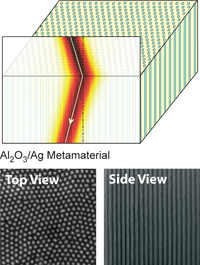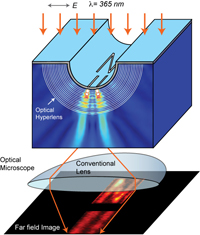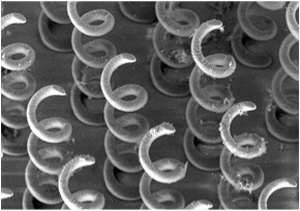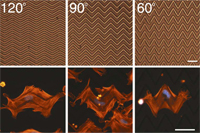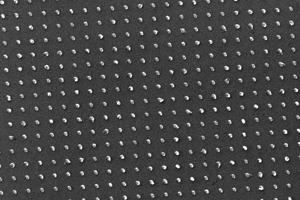Research Projects
Optical Metamaterials
|
Metamaterials are a new class of artificial nanocomposites that exhibit exceptional properties not readily observed in nature. These properties arise from qualitatively new response functions that are: (1) not observed in the constituent materials and (2) result from the inclusion of artificially fabricated, extrinsic, low dimensional inhomogeneities. Through combined thoertical and experimental studies, we are interested to explore electromagnetic metamaterials with unprecedented characteristics such as:
|
Super-resolution Nanoimaging
|
To reproduce a flawless image of an object without diffraction is always a dream of lens makers. In conventional lenses, however, spatial resolutions in imaging are limited by the diffraction at the order of wavelength. Standard optical microscopes are not able to discern objects closer than 200 nm due to such fundamental limit. The usefulness of optical microscopy, however, is a strong reason to seek methods that overcome the present resolution limits. Our goal is to resolve the sub-diffraction-limited features at far-field by magnifying the evanescent waves using artificially structured metamaterials lenses. |
3D Micro-/Nano-fabrication
|
Microstereolithography is a solid freeform technique that builds 3D microstructures by solidifying UV curable polymers in a layer-by-layer fashion. This technique is scalable with feature size ranging from micron to centimeter and total sample size up to 12 inch, and can be seamlessly integrated with CAD tools. To convert polymers to metals and other functional materials, mold transfer techniques such as sputtering, electroplating and micromolding is being developed and coupled to SL fabrication. We are also exploring Nano-scale 3D lithography using high-resolution metamaterials lenses. |
Nano-bio Interface
|
Contemporary research on molecular biology reveals the richness of molecular signaling complexes that carry and process messages inside a living cell associated with compact clusters of molecules. These signaling modules attached to cell membranes or the cytoskeleton operate as computational units in response to a variety of physical and chemical stimuli. By interfacing living cells through mechanical, electrical, and optical stimuli and simultanously sensing the resulting cellular signaling modules, it will open up the exciting gateway to decipher the basic biological functions in living organism. |
Solar Energy Conversition
|
The motivation is to look explore the processes of light coupling with engineered nanophotonic structures as a means to increase quantum efficiency of solar energy conversion at broad solar emission spectrum. Solar radiation provides a readily available source of free energy, which if efficiently taped could solve the most urgent problem facing the industrialized world. In this project, we are interested to investigate the possibility for increasing energy conversion efficiency by engineering a strongly localized electromagnetic field with wide band response by introducing plasmon resonance in metallic nanostructures. |

